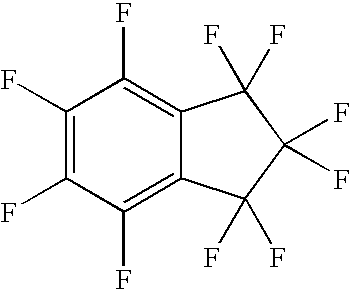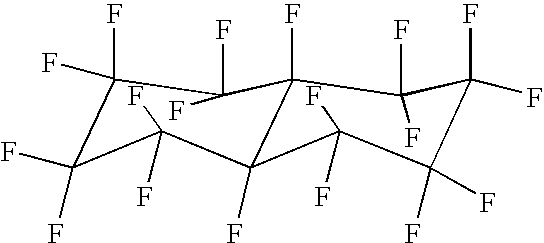Tracer-containing compositions
a tracer compound and composition technology, applied in the field of compression refrigeration and air conditioning, can solve the problems of unfavorable consumer replacement of leaked refrigerant, waste of existing resources, etc., and achieve the effect of not being as great, unnecessary waste and cost to consumers
- Summary
- Abstract
- Description
- Claims
- Application Information
AI Technical Summary
Problems solved by technology
Method used
Image
Examples
example 1
[0039] A sample of R-22 (refrigerant HCFC-22, chlorodifluoromethane) was spiked with 100 parts per million (ppm by weight) of PFC-C318 (perfluorocyclobutane). The sample was then analyzed by GC using the conditions described below: [0040] Column: RTx®-1701 (Crossbond® 14% cyanopropylphenyl / 86% dimethyl polysiloxane) [0041] Length: 105 meters [0042] Inner diameter: 0.25 millimeters [0043] Stationary phase film thickness: 0.25 micrometers [0044] Carrier gas and flow rate: He, 1.0 milliliter / minute [0045] Oven temperature: [0046] Initial temperature: −20° C. [0047] Initial hold time: 15 minutes [0048] Temperature ramp rate: 10° C. / minute [0049] Final temperature: 50° C. [0050] Final hold time: 0 minutes (no final hold time) [0051] Detector: Flame ionization detector (FID) [0052] Temperature: 250° C. [0053] Hydrogen flow rate: 42 milliliter / minute [0054] Airflow rate: 450 milliliter / minute [0055] Injection port: Split [0056] Temperature: 150° C. [0057] Head pressure: 22 psi [0058] Sampl...
example 2
[0062] A sample of R-134a (refrigerant HFC-134a, 1,1,1,2-tetrafluoroethane) was spiked with 100 parts per million (ppm by weight) of HFC-236fa (1,1,1,3,3,3-hexafluoropropane). The sample was then analyzed by GC using the conditions described below: [0063] Column: RTx-1 (Crossbond® 100% dimethyl polysiloxane) [0064] Length: 105 meters [0065] Inner diameter: 0.25 millimeters [0066] Stationary phase film thickness: 1.0 micrometers [0067] Carrier gas and flow rate: helium, 0.75 milliliter / minute [0068] Oven temperature: [0069] Initial temperature: −20° C. [0070] Initial hold time: 13 minutes [0071] Temperature ramp rate: 50° C. / minute [0072] Final temperature: 50° C. [0073] Final hold time: 10 minutes [0074] Detector: Flame ionization detector (FID) [0075] Temperature: 250° C. [0076] Hydrogen pressure: 20 psi [0077] Air pressure: 45 psi [0078] Injection port: Split [0079] Temperature: 175° C. [0080] Head pressure: 38 psi [0081] Sample type: vapor, manual syringe injection [0082] Sample ...
example 3
[0085] A sample of R-410A (refrigerant blend, 50 weight percent R-32, difluoromethane, and 50 weight percent R-125, pentafluoroethane) was spiked with 100 parts per million (ppm by weight) of HFE-236fa (1-trifluoromethoxy-2,2,2-trifluoroethane). The sample was then analyzed by GC using the conditions described below: [0086] Column: 5% Fluorcol® on Carbopack® B, 60 / 80 mesh [0087] Length: 20 feet (6.1 meters) [0088] Diameter: ⅛ inch (0.32 centimeter) [0089] Carrier gas and flow rate: helium, 30 milliliter / minute [0090] Oven temperature: [0091] Initial temperature: 60° C. [0092] Initial hold time: 3 minutes [0093] Temperature ramp rate: 8° C. / minute [0094] Final temperature: 180° C. [0095] Final hold time: 10 minutes [0096] Detector: flame ionization detector (FID) [0097] Temperature: 250° C. [0098] Hydrogen pressure: 20 psi [0099] Air pressure: 45 psi [0100] Injection port: Packed [0101] Temperature: 250° C. [0102] Head pressure: 67 psi [0103] Sample type: vapor, sample valve injectio...
PUM
 Login to View More
Login to View More Abstract
Description
Claims
Application Information
 Login to View More
Login to View More - R&D
- Intellectual Property
- Life Sciences
- Materials
- Tech Scout
- Unparalleled Data Quality
- Higher Quality Content
- 60% Fewer Hallucinations
Browse by: Latest US Patents, China's latest patents, Technical Efficacy Thesaurus, Application Domain, Technology Topic, Popular Technical Reports.
© 2025 PatSnap. All rights reserved.Legal|Privacy policy|Modern Slavery Act Transparency Statement|Sitemap|About US| Contact US: help@patsnap.com



